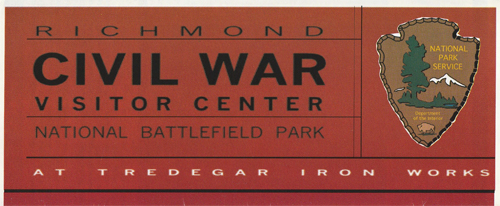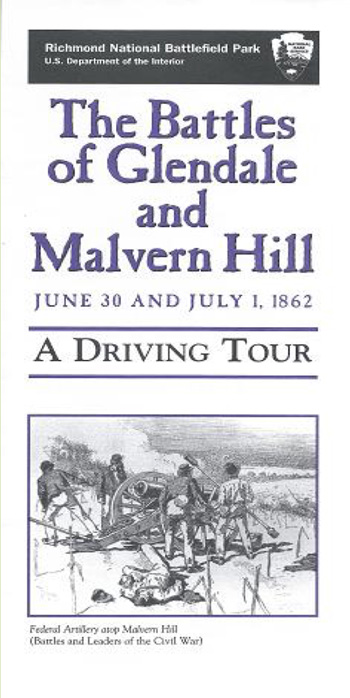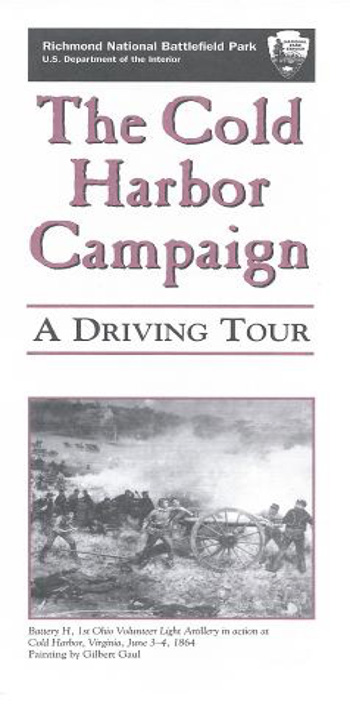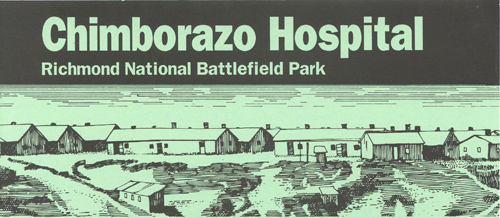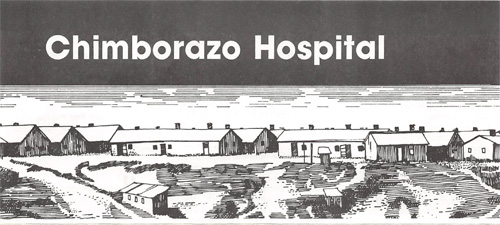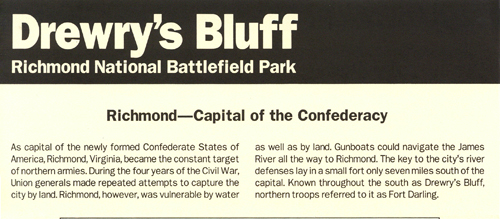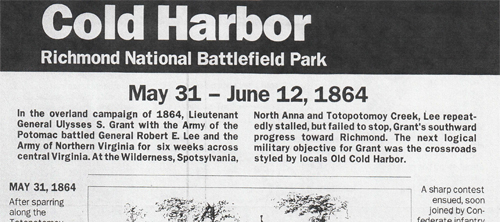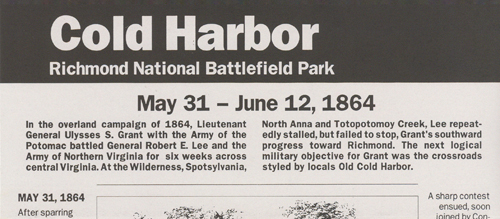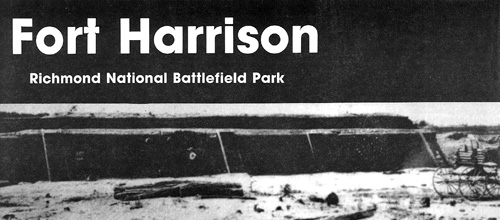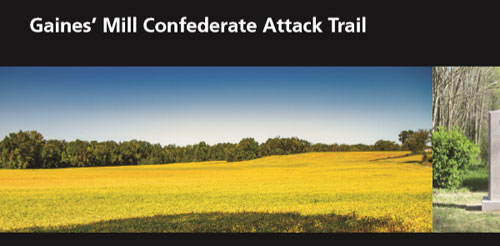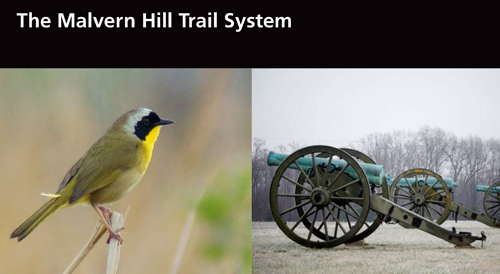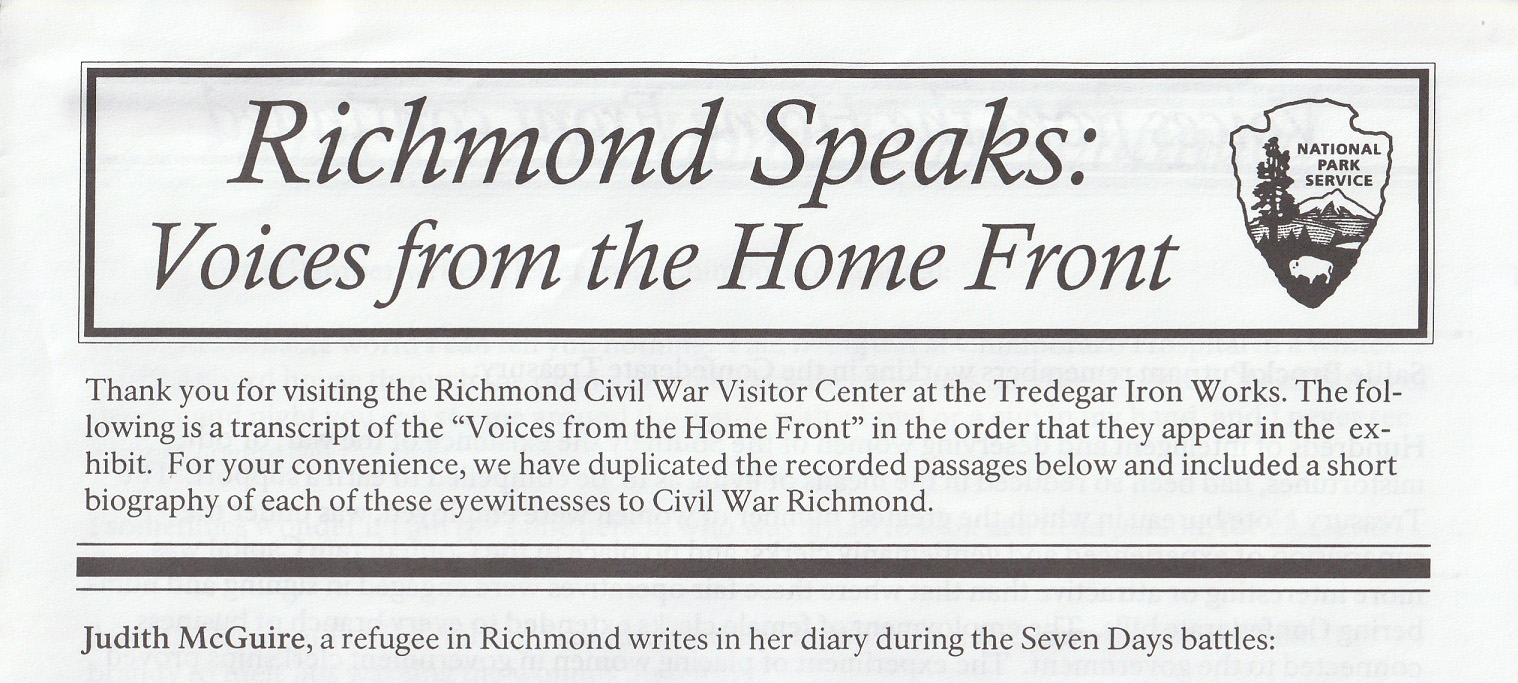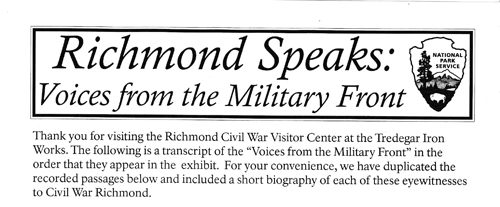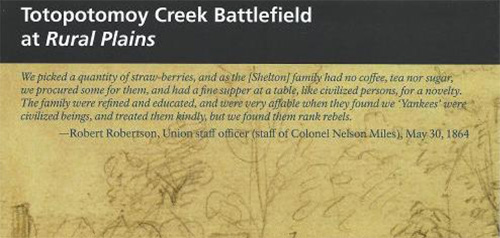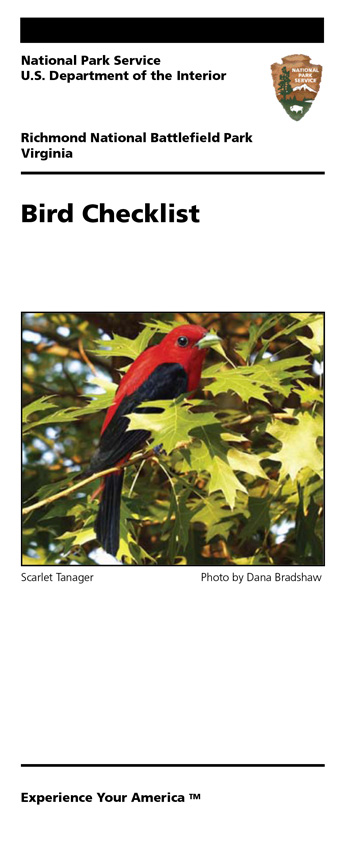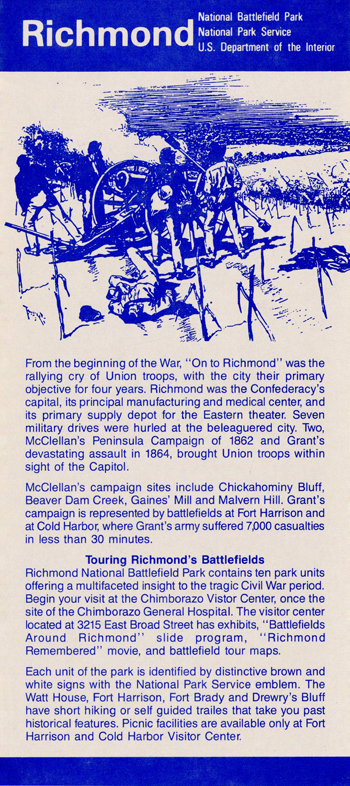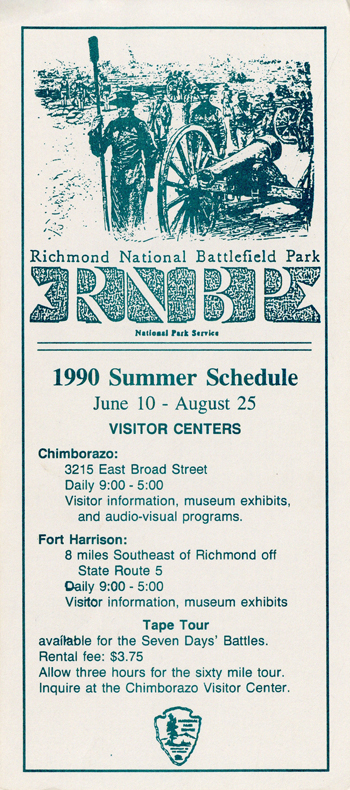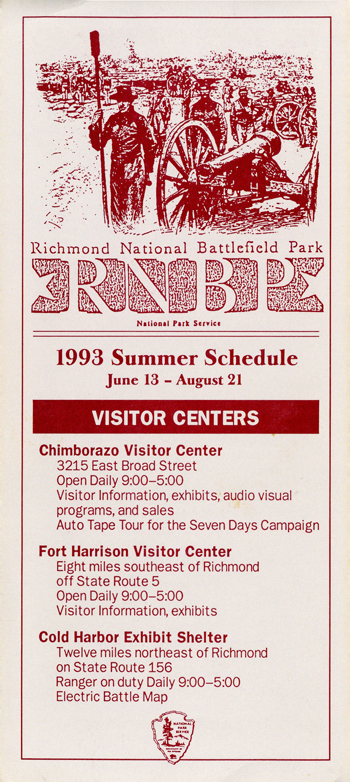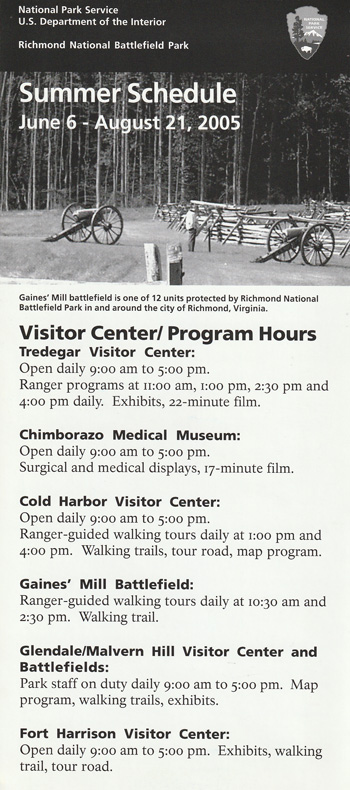|
Richmond National Battlefield Park Virginia |
 |
 NPS photo | |
"I have always regretted that the last assault at Cold Harbor was ever made no advantage was gained to compensate for the heavy loss we sustained"
—Lt. Gen. Ulysses S. Grant
Embattled Capital 1861-1865
Almost from the war's first shots Richmond was a focal point in the conflict. Although other Southern cities were more populous, or enjoyed safer locations, no place in the Confederacy combined as many important features as Richmond. Strategically placed on the James River, with an active commercial, manufacturing, and transportation infrastructure, Richmond stood tall as one of the South's premier cities. When the Confederate government established Richmond as its capital in May 1861, it ensured that central Virginia would be the center of the coming storm.
Richmond was worth fighting for. Tredegar Iron Works, perched on the banks of the river, formed a prominent part of the city's industrial capability. Five railroads radiated from the city like spokes on a wheel, directly connecting Richmond with every part of the state, and indirectly linking it with the Deep South. Defending Richmond proved dangerous but not unmanageable. The Rappahannock, North Anna, Pamunkey, and Chickahominy rivers each offered substantial lines of resistance to block Northern armies.
Events elsewhere in the South elevated the importance of Richmond still more. A series of Union victories in early 1862 constricted the boundaries of the Confederacy. In February, Federal soldiers and sailors wrested away control of the Tennessee River during battles at Fort Henry and Fort Donelson. The capture of New Orleans in April deprived the Confederacy of both its largest city and the mouth of the Mississippi River. Later lodgments in the Carolinas, along the Confederacy's southeastern coast, damaged the South logistically and psychologically.
Faced with a long series of setbacks, Confederates found cause for optimism in the successful defense of Richmond in the Peninsula Campaign. Gen. Robert E. Lee's 1862 offensive, called the Seven Days' Battles, saved the city from capture. While other key locations toppled, Richmond held firm. Lee's success in protecting the capital city shaped the course of the war's middle years. Riding a wave of enthusiasm, Lee took the war to northern Virginia (the Second Battle of Manassas or Bull Run) and ultimately into Maryland (the Battle of Sharpsburg or Antietam) and Pennsylvania (the Battle of Gettysburg). Meanwhile Richmonders entrenched, using mostly slave labor to construct dozens of miles of earthen fortifications to protect the capital city.
The spring of 1864 brought a series of decisive changes to the war. Lt. Gen. Ulysses S. Grant took charge of all the Union armies in March and forged a strategy that threatened nearly every unconquered corner of the Confederacy. Federal troops launched offensives in Georgia and Louisiana that slowly eroded the transportation and supply systems of the South. In Virginia, Grant fielded three large armies that operated in separate parts of the state, yet in tandem with each other. None of the columns won startling victories, but their combined presence applied unceasing pressure on Richmond.
March 1864 also witnessed the arrival of the first African-American prisoners of war in Richmond. The Union army had been organizing military units designated United States Colored Troops for some time, but their presence with the main Federal army in Virginia signaled a new era. As the fighting dragged on into summer, those regiments saw increasing activity in battles outside the capital, notably at New Market Heights and Fort Gilmer.
Because of its many railroad lines, and its proximity to the main Confederate army in Virginia, Richmond became a medical center early in the war with dozens of hospitals. By 1864 the government had pruned the number to only a few, most of them large facilities like Chimborazo that resembled small, independent cities. The increasing shortages toward the end of the war affected these hospitals, too, adding another burden to the strained supply system in Virginia as well as elsewhere in the Confederacy.
While many of Richmond's residents worried about their daily subsistence, the armies continued to hammer at each other. The fields and forests immediately around the city saw at least 25 battles, many occurring during the last 10 months of the war when the armies fought a series of actions south and east of Richmond. The fighting stretched beyond the James River to Petersburg, and Federal forces frequently attacked the defenses of both cities simultaneously. The capture of either city would ensure the capitulation of the other. On April 2, 1865, after 10 months of resistance, Petersburg fell, forcing the evacuation of Richmond.
Before Union soldiers entered Richmond on April 3, the Confederate government authorized the burning of warehouses and supplies, which resulted in considerable damage to the factories and houses in the city's business district. Before the charred ruins of Richmond had cooled, Lee surrendered the remnant of his army to Grant at Appomattox Court House on April 9, 1865. The collapse of the Confederacy followed swiftly.
Highlights of the Richmond Story
Tredegar Iron Works
The Tredegar Iron Works was already well known when the Civil War began in 1861. Named for an iron works in Wales, Tredegar began in 1836 as a small forge and rolling mill. The site was shared with other milling operations that harnessed water power from the James River and Kanawha Canal to run the milling equipment. In the two decades before the war, Tredegar, along with other smaller iron foundries, made Richmond the center of iron manufacture in the southern United States. By i860, the iron works, under the supervision of Joseph R. Anderson, utilized about 800 laborers, both black and white, free and slave.
During the Civil War, Tredegar covered an area of nearly five acres, and operations continued day and night to meet the demands of the Confederacy for artillery, ammunition, and other war-related materials. Despite shortages in iron and manpower, the foundries were able to produce almost 1,100 field and siege cannon, and its rolling mills provided the armor plating that protected the casemates of several Southern warships, including the C.S.S. Virginia. On April 2, 1865, when warehouses along the James River were being burned by evacuating Confederates, Tredegar was saved by an armed battalion of workers who blocked any attempt by mobs to destroy the foundry buildings. The iron works would play an important role in rebuilding the devastated South after 1865.
"Richmond must not be given up; it shall not be given up."
—Robert E. Lee, May 1862
The Commanders
Joseph E. Johnston
A Confederate general who favored planning over campaigning, his tactics
during the Peninsula Campaign delayed, but did not stop, the Union
advance. Wounded at the Battle of Seven Pines, he was replaced by Robert
E. Lee.
Robert E. Lee
Offered command of United States troops in April 1861, he chose to join
the Confederacy instead. Under his leadership, the Army of Northern
Virginia fought valiantly to defend Richmond against repeated Federal
onslaughts.
George B. McClellan
A superb military organizer, his creation, the Union Army of the
Potomac, was a finely disciplined body of soldiers. His dilatory tactics
in the Seven Days' Battles, however, prevented his army from capturing
Richmond.
Ulysses 5. Grant
As general in chief of all Union armies, he vowed that wherever Lee went
he would follow. His relentless 1864-65 campaign proved costly to the
North but finally resulted in the surrender of Richmond and the defeat
of Lee.
"Each man...gets well or dies [knowing] that there is someone by his pillow...doing all that can be done."
—Phoebe Yates Pember, hospital matron
Chimborazo: "Hospital on the Hill"
Chimborazo Hospital opened in October 1861. It covered more than 40 acres and operated nearly 100 wards grouped into five divisions. Each ward housed up to 32 patients, giving the entire hospital a capacity of more than 3,000. Every division had its own laundry, kitchen, and bathhouse, and a central bakery and dairy serviced the entire facility, making Chimborazo one of the Confederacy's best equipped hospitals as well as one of its largest. More than 76,000 Confederate sick and wounded were treated here. Chimborazo had a patient mortality rate of under 20 percent, dismal by today's standards but quite good in terms of 19th-century medicine, before the days of antibiotics, antiseptic surgery, and widespread understanding of germ theory.
Valor at New Market Heights
Wherever black regiments were engaged in battle during the Civil War, they acquitted themselves in a manner that fully justified the policy of the U.S. Government in enlisting their services in 1862. Upon the opening of Grant's Overland Campaign of 1864, African-American soldiers were a common feature of the armies before Richmond. Some of the hardest fighting done by black soldiers during the nine-month siege of Richmond and Petersburg occurred on September 29, 1864, when three brigades of United States Colored Troops participated in costly assaults against formidable Confederate entrenchments at New Market Heights. Fourteen black soldiers were later awarded the Medal of Honor for heroic conduct during this action. Two of those soldiers are shown at left.
What Richmond Endured
Richmond never came under direct assault or even long-range bombardment but it endured its share of hardships. The war brought thousands of refugees, industrial workers, and civil and military officials into the city, as well as the riffraff that collect in any wartime capital. Its population grew to more than 125,000 at a time when farmers had no crops to sell and resources were beginning to dwindle. Richmond's residents fought a losing battle against scarcity and inflation. Prices soared. Hunger was ever present. In April 1863, in the market area, there was a food riot that Jefferson Davis helped to mollify. By the end of the war, food had become so scarce that the sight of a pigeon on the wing was a rarity, and clothing and shelter could be had only at great costs.
A Richmond Timeline 1861-1865
February 18 Jefferson Davis is inaugurated president of the Confederate States of America in Montgomery, Ala.
April 12 Confederate troops bombard Fort Sumter in Charleston Harbor, S.C. Civil War begins.
April 17 Virginia State Convention adopts secession ordinance and instructs the governor to call for volunteers to protect the state from Federal encroachment.
April 27 Virginia Convention invites the Confederate legislators to make Richmond seat of the new government.
May 21 Richmond designated capital of the Confederacy.
July 21 Confederates halt first Union attempt to capture Richmond at the First Battle of Manassas or Bull Run, Va.
October 17 Chimborazo Hospital opens in Richmond.
March 17 Union army assembles at Fort Monroe, beginning the Peninsula Campaign.
May 15 Five Union ships, including the Monitor, are repulsed at Drewry's Bluff on the James River.
May 31 Confederates launch major attack at Battle of Seven Pines, just east of the city. Joseph E. Johnston is wounded.
June 1 Robert E. Lee assumes command of the Army of Northern Virginia.
June 25 Seven Days' Battles begin with Union attack at Oak Grove, near Seven Pines.
June 26 Battle of Beaver Dam Creek opens Confederate offensive during the Seven Days' Battles.
June 27 Battle of Gaines' Mill.
June 29 Battle of Savage's Station.
June 30 Battle of Glendale (or Frayser's Farm).
July 1 Union victory at Battle of Malvern Hill signals end of Seven Days' Battles.
January 1 Emancipation Proclamation declares free all slaves in areas in rebellion.
March 13 Explosion at Confederate Ordnance Laboratory on Browns Island kills or injures 69, including 62 women.
April 2 A "bread riot" breaks out on Main and Cary streets.
May 3-4 Raid of Stoneman's Union cavalry threatens Richmond.
May 15 Fire seriously damages Tredegar Iron Works, forcing weeks of repair.
June 25-26 Union cavalry threaten city and destroy Virginia Central Railroad bridge over the North Anna River.
July 3-4 Union forces strike the Richmond, Fredericksburg & Potomac Railroad north of Richmond and destroy the bridge over the South Anna River.
Summer Work on earthen defenses outside Richmond increases.
February 9 109 Union prisoners tunnel to freedom from Libby Prison; 48 are recaptured.
February 29 Kilpatrick-Dahlgren Raid toward Richmond ends in failure.
May 5 The Union Army of the James lands below Richmond at Bermuda Hundred.
May 11 Battle of Yellow Tavern just north of city.
May 16 Benjamin F. Butler's Army of the James defeated at the Second Battle of Drewry's Bluff.
May 23-26 Grant and Lee engage along North Anna River, 25 miles north of city.
May 28 Battle of Haw's Shop, 13 miles northeast of the city.
May 28-June 1 Armies draw closer to city. Fighting at Totopotomoy Creek.
May 30 Battle of Bethesda Church is heard in Richmond.
May 31-June 12 Battle of Cold Harbor. Grant fails to reach Richmond on the direct route.
June 14 Grant's army begins crossing James River toward Petersburg.
July 27-30 First Battle of Deep Bottom.
August 14-20 Second Battle of Deep Bottom (or Fussell's Mill).
September 29-30 Union offensive at Fort Harrison and New Market Heights.
October Battles along Darbytown Road and at Fair Oaks prove indecisive.
January 24 Battle of Trent's Reach is last gasp of Confederate navy below city.
April 2 Confederate government departs Richmond by train.
April 3 Union troops enter Richmond and help extinguish fires raging in the business district.
April 4 President Lincoln visits Richmond.
April 9 Grant and Lee discuss terms of surrender at Appomattox Court House, Va.
Touring Richmond's Battlefields
Where to Start
Begin your visit at the Richmond National Battlefield Park Civil War Visitor Center at 490 Tredegar Street. The visitor center is on the site of Tredegar Iron Works, the Confederacy's most important iron foundry and rolling mill. Here exhibits and audiovisual programs introduce you to the story of Richmond during the Civil War and the battlefields that surround the city. National Park Service staff will answer your questions and provide historical information. Schedules of Living History programs and other events are available. Additional exhibits can be found year-round at the Cold Harbor Visitor Center and the Chimborazo Medical Museum, and seasonally at the Glendale/Malvern Hill Visitor Center and the Fort Harrison Visitor Center.
Battlefield Tour
Richmond National Battlefield Park consists of the 10 units listed below plus the Civil War Visitor Center and the Chimborazo Medical Museum.
A complete tour of the park involves an 80-mile drive as outlined on the map. If you only have a limited amount of time, there are four places you really should plan to see: the visitor center at the site of the historic Tredegar Iron Works and the Gaines' Mill, Malvern Hill, and Cold Harbor battlefields.
Note: Check at park visitor centers for information about the 1862 Peninsula Campaign and Lee vs Grant driving tours, which include numerous stops near park battlefields. Each tour is part of a series of driving tours sponsored by Virginia Civil War Trails linking both well-known and less familiar Civil War sites in Virginia.
1862 Seven Days Battle
The 1862 Peninsula Campaign, a massive Union operation directed against Richmond, began in March 1862 and ended five months later. After landing on the tip of Virginia's southeastern peninsula, the Federal army under George B. McClellan pushed slowly toward the Confederate capital. At Yorktown a smaller Confederate force blocked the Northern army by fortifying the neck of the narrow peninsula. Eventually Federal naval superiority opened a route past the defenses and McClellan pressed the Southern army back to the outskirts of Richmond.
At the Battle of Seven Pines on May 31, Confederate army commander Joseph E. Johnston fell wounded and was replaced by Robert E. Lee. Three weeks later, Lee attacked McClellan in a series of encounters known as the Seven Days' Battles that forced the Federal army away from Richmond and changed the course of the war in Virginia. After August, only a small Union garrison, inactive for most of the war, remained on the lower peninsula. The sudden change in fortunes cleared the way for later battles in northern Virginia and the Confederate invasion of Maryland.
Chickahominy Bluff A part of the outer Confederate line defending Richmond, this bluff offered a view of Mechanicsville and the Chickahominy River Valley. Within sight of the earthworks here, Gen. Robert E. Lee witnessed the start of the Battle of Beaver Dam Creek on June 26.
Beaver Dam Creek Part of the two-mile Union front that Confederates unsuccessfully attacked on June 26 lies here in the valley of Beaver Dam Creek at Ellerson's Mill. Few Confederates crossed the stream as Union artillery and infantry fire stopped Lee's attack all along the line. A pedestrian bridge allows visitors to cross over the creek and see the site of the heaviest fighting of the battle.
Gaines' Mill (Watt House) On June 27, Confederate infantry repeatedly assaulted the fortified Union line along Boatswain Creek, about one mile from the mill. By nightfall both armies had suffered a combined total of more than 15,000 casualties in the heaviest fighting of the Seven Days' Battles. The Watt House, built about 1820 for the owner of a mid-sized plantation and currently not open to the public, served as Union Gen. Fitz John Porter's headquarters. The short trail beginning near the house leads to the site where Texas and Georgia troops broke through the line and precipitated the Union withdrawal. A monument also honors members of an Alabama brigade who fought valiantly in the closing hours of the battle.
Glendale (Frayser's Farm) On June 30, Union troops protected the vital crossroads near the old Frayser farm, Glendale, while McClellan's army retreated south toward Malvern Hill. Throughout the afternoon, Confederate forces repeatedly attacked the position but failed to carry it. The following day, when a Confederate general commented that it appeared that McClellan would escape, a frustrated Lee responded: "Yes, he will get away because I cannot have my orders carried out." A visitor center at the Glendale National Cemetery lodge features a fiber optic map that relates the story of the battles at Glendale and Malvern Hill.
Malvern Hill Fought July 1, this was the last of the Seven Days' Battles, after which McClellan withdrew to his base at Harrison's Landing. The Federals, on the defensive, dug no trenches. Instead they stood in battle formation across the gently sloping fields, their massed artillery and infantry fire shattering the ranks of the attacking Confederates. The steep slopes of Malvern Hill on the Union left and the swampy lowlands on the right forced the southerners to advance across open ground. Part of the battlefield has been restored to its 1862 appearance and cannon have been placed to mark Union and Confederate artillery positions. Follow the 1½-mile walking trail to view the fields across which thousands of Confederate infantry attacked.
Drewry's Bluff Union soldiers referred to this Confederate guardian of the James River as Fort Darling. On May 15, five Federal vessels, including the famous ironclad Monitor, attacked the fort but were driven off. The successful defense prevented Richmond from being shelled early in the war, and the presence of the fort was a deterrent to other Union naval forays up the James. John F. Mackie, a corporal in the U.S. Marine Corps, was later awarded the Medal of Honor for conspicuous bravery during the attack on Fort Darling. He was the first U.S. Marine to receive the medal. The fort and surrounding area served as the Confederate Naval Academy and Marine Corps Camp of Instruction during much of the war. Exhibits along a self-guiding walking trail give details of the fort's history.
1864 Overland Campaign
The Overland Campaign conducted by the primary Union army in Virginia began in May 1864 at the Battle of the Wilderness and continued through Spotsylvania, Cold Harbor, and on to Petersburg. Unlike some earlier campaigns, this effort was part of a coordinated surge all across the South. Other Union armies operated in the Shenandoah Valley in western Virginia, below Richmond on the Bermuda Hundred peninsula, and against the important Confederate rail and industrial city of Atlanta, Ga. The combined pressure ultimately succeeded in stretching Southern military resources beyond their capacity.
Cold Harbor Here Confederates blocked Grant's path to Richmond by building powerful entrenchments stretching six miles between Bethesda Church and the Chickahominy River. On June 1 and June 3, Union forces tested these defenses with massive, ill-conceived assaults. The June 3 fighting alone resulted in nearly 6,000 Federals being killed or wounded, most of them in one hour's time. During the two-week battle, the combined casualties for both armies were at least 16,000 men. The well-preserved trenches along the 1¼-mile tour road are find examples of Civil War field fortifications. The actions at Cold Harbor changed the course of the war in the East from a war of maneuver to one of siege. Cold Harbor also influenced the strategy and tactics of future wars by demonstrating that well-selected, well-manned entrenchments, supported by artillery, were practically impregnable against frontal assaults. A one-mile walking trail begins at the visitor center. An electric battle map in the visitor center depicts movements of the two armies from May 31 until June 12. Cold Harbor National Cemetery contains the remains of over 2,000 Union soldiers, more than 1,300 of whom are unknown.
Garthright House This restored house served as a Union field hospital during the Battle of Cold Harbor. It afterwards became a Confederate hospital. The house, parts of which date to the 1700s, is an exterior exhibit only and not open to the public. Nearby, Hanover County's Cold Harbor Park offers a one-mile walking trail past Union artillery and infantry trenches. Fort Harrison and Vicinity After Cold Harbor, General Grant crossed the James River and directed his main effort against Petersburg. In a surprise attack designed to prevent Lee from shifting troops to another sector of operations, Union soldiers captured Fort Harrison on September 29. The gallantry of several regiments of black Union troops that day was recognized by the awarding of Medals of Honor to 14 black soldiers. The fort was occupied and enlarged by the Federals, thus forcing a realignment of Richmond's southern defenses. Exhibits and signs along a self-guiding walking trail provide details of the battle and the fort. Forts Gilmer, Gregg, Johnson, and Hoke were all Confederate defense works connected by miles of breastworks. Union Fort Brady anchored the line from Fort Harrison. It was constructed after September 29 to prevent Confederate gunboats from moving downriver to threaten Grant's supply system.
Parker's Battery This small Confederate artillery position was part of the Howlett Line, a chain of entrenchments that stretched from Battery Dantzler on the James River south to the Appomattox River and "bottled up" Union Maj. Gen. Benjamin F. Butler's Army of the James in the spring of 1864. After watching Butler fall back into the Bermuda Hundred peninsula, the men of Parker's Virginia Battery built this strongpoint and helped to seal off the southerly route to Richmond. A short walking trail begins at the parking area.
 (click for larger map) |
About Your Visit
Richmond National Battlefield Park is one of more than 380 parks
representing important examples of our country's natural and cultural
heritage. Each unit of the park is identified by distinctive brown
signs, and each is interpreted by National Park Service historical
markers. Chickahominy Bluff, Malvern Hill, Fort Harrison, Fort Gilmer,
and Drewry's Bluff have interpretive facilities featuring an audio
station and exhibits.
Whenever possible, spend some time walking in each area; it is the best way to understand the battlefields. Beaver Dam Creek, Gaines' Mill, Malvern Hill, Cold Harbor, Fort Harrison, Fort Brady, Parker's Battery, and Drewry's Bluff have short self-guiding trails that take you past historical features. Help us maintain the historic features of the park by staying on the designated walking trails. Picnic facilities are available only at Fort Harrison and the Garthright House.
For Your Safety
While every effort is made to provide for your safety, you must remain
alert and cautious. Drive carefully: the park roads are narrow, winding,
and intended for leisurely enjoyment. Pay particular attention to speed
limits and warning signs on park roads. Park only in paved areas. Stay
on designated trails. Do not stray into woods, where you may encounter
poison ivy and ticks. Be alert for poisonous snakes. First aid is
available at the visitor centers or from park staff. In the case of
emergencies, dial 911.
Remember
All historic artifacts within National Park Service areas are protected
under Federal law. The possession or use of metal detectors on park land
is punishable by a fine and/or imprisonment and possible loss of
equipment. Picnicking is permitted only in designated areas. The
possession and/or consumption of alcoholic beverages in the park is
prohibited. So, too, are athletic or recreational activities that
intrude on or interfere with visitors in historic areas.
Source: NPS Brochure (2005)
|
Establishment Richmond National Battlefield Park — March 2, 1936 |
For More Information Please Visit The  OFFICIAL NPS WEBSITE |
Brochures ◆ Site Bulletins ◆ Trading Cards

Documents
Assessment of an Urban Landfill on Tributary Water Quality: Fort Darling Unit of the Richmond National Battlefield Park, Virginia NPS Technical Report NPS/NRWRD/NRTR-94/35 (Del Wayne R. Nimmo, Mary J. Willox, John F. Karish, John D. Tessari, Terri L. Craig, Ervin G. Gasser and James R. Self, November 1994)
Bird and Herpetofaunal Inventories of Eight Unit and Tract Additions to Richmond National Battlefield Park, Virginia NPS Natural Resource Technical Report NPS/MIDN/NRTR—2013/828 (J. Edward Gates and Donald G. Mackler, December 2013)
Conserving Richmond's Battlefields Draft (October 1990)
Cultural Landscape Report for Glendale Battlefield, Richmond National Battlefield Park: Site History, Existing Conditions, Analysis and Evaluation, Treatment Olmsted Center for Landscape Preservation (John W. Hammond, 2019)
Cultural Landscape Report for Rural Plains, Richmond National Battlefield Park: Treatment Olmsted Center for Landscape Preservation (John W. Hammond, 2016)
Cultural Landscape Treatments/Draft Environmental Assessment: Malvern Hill and Glendale Units, Richmond National Battlefield Park (December 2003)
Cultural Landscapes Inventory: Beaver Dam Creek Battlefield, Richmond National Battlefield Park (2022)
Cultural Landscapes Inventory: Chickahominy Bluff, Richmond National Battlefield Park (1999)
Cultural Landscapes Inventory: Cold Harbor Battlefield, Richmond National Battlefield Park (2022)
Cultural Landscapes Inventory: Crater Battlefield, Richmond National Battlefield Park (2017)
Cultural Landscapes Inventory: Drewry's Bluff, Richmond National Battlefield Park (1999)
Cultural Landscapes Inventory: Fort Harrison, Richmond National Battlefield Park (2015)
Cultural Landscapes Inventory: Gaines' Mill Battlefield, Richmond National Battlefield Park (2024)
Cultural Landscapes Inventory: Glendale Battlefield, Richmond National Battlefield Park (2017)
Cultural Landscapes Inventory: Malvern Hill Battlefield, Richmond National Battlefield Park (2017)
Cultural Landscapes Inventory: Parker's Battery, Richmond National Battlefield Park (1999)
Cultural Landscapes Inventory: Richmond NBP Landscape, Richmond National Battlefield Park (2024)
Foundation Document, Richmond National Battlefield Park, Virginia (April 2017)
Foundation Document Overview, Richmond National Battlefield Park, Virginia (January 2017)
Geologic Map of Richmond National Battlefield Park (March 2024)
Geologic Resources Inventory Report: Richmond National Battlefield Park NPS Science Report NPS/SR-2024/202 (Trista L. Thornberry-Ehrlich, October 2024)
Historic Structures Report, Architectural Data: Garthright House (Russell Jones, March 1971)
Historic Structure Report: The Shelton House at Rural Plains, Richmond National Battlefield Park, Mechanicsville, Virginia (Barbara A. Yocum, August 2012)
Historical Landscape Study: Terrain of Cold Harbor Battlefield, June 1, 1864 (Clifford R. Dickinson, August 8, 1988)
Historical Landscape Study: Terrain of Gaines' Mill Battlefield, June 27, 1862 (Clifford R. Dickinson, February 11, 1990)
Interpretive Prospectus, Richmond National Battlefield Park, Virginia (1971)
Junior Ranger Activity Book, Richmond National Battlefield Park (Date Unknown; for reference purposes only)
Long-Range Interpretive Plan, Richmond National Battlefield Park, Virginia (April 1997)
Master Plan, Richmond National Battlefield Park, Virginia (1971)
Natural Resource Condition Assessment, Richmond National Battlefield Park, Virginia NPS Natural Resource Report NPS/NER/NRR-2012/548 (Rebecca M. Schneider, Aaron F. Teets and Jessica L. Dorr, June 2012)
Park Newspaper (The Quarterly)
1999: Fall 1999
2000: Winter 2000 • Spring 2000 • Summer 2000 • Fall 2000
2001: Winter 2001 • Spring 2001 • Summer 2001 • Fall 2001
2002: Winter 2002 • Spring 2002 • September 2002
2003: March 2003 • July 2003
2004: March 2004 • June 2004 • September 2004
2005: March 2005 • 2005
2006: January 2006 • June 2006 • December 2006
2007: May 2007 • September 2007
2008: June 2008 • November 2008
2009: July 2009
Richmond Battlefields: Historic Handbook Series No. 33 (HTML edition) (Joseph P. Cullen, 1961)
State of the Park Report, Richmond National Battlefield Park, Virginia State of the Park Series No. 19 (2015)
Survey Report: Restoration of the Watt House, Hanover County, Virginia (John T. Willett, November 4, 1956)
Troop Movements at the Battle of Cold Harbor (Richmond Civil War Centennial Committee, 1964)
Vegetation Classification and Mapping at Richmond National Battlefield Park, Virginia NPS Natural Resource Technical Report NPS/NER/NRTR-2008/128 (Karen D. Patterson, June 2008)
Vegetation Classification and Mapping of Land Additions at Richmond National Battlefield Park, Virginia: Addendum to Technical Report NPS/NER/NRTR—2008/128 NPS Natural Resource Report NPS/NER/NRR—2015/903 (Kristin Taverna, January 2015)
Richmond National Battlefield Park (1990)
Books

rich/index.htm
Last Updated: 10-Oct-2024















